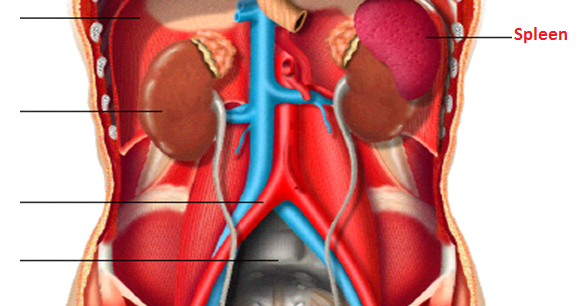
A splenectomy is an operation to remove the spleen and some patients with lymphoma might need a splenectomy? We can live without a spleen however, without a spleen, the body is less able to fight infections. Without a spleen, precautions are needed to lower the risk of getting infections.
What is the spleen?
The spleen is a fist-shaped, oblong organ that is purple, and it weighs about 170 grams in healthy individuals. It is located behind the ribs, under the diaphragm, and above and behind the stomach on the left-hand side of the body.
The spleen plays multiple supporting roles in the body that includes:
- It acts as a filter for blood as part of the immune system
- Old red blood cells are recycled in the spleen
- Makes antibodies
- Platelets and white blood cells are stored in the spleen
- Storing extra blood when it is not needed
- The spleen also helps fight certain kinds of bacteria that cause pneumonia and meningitis
Symptoms of an enlarged spleen
Symptoms generally come on gradually and can sometimes start off being vague until they become more severe. Symptoms include:
- Pain or sense of fullness in left side of your abdomen
- Feeling full soon after eating
- Fatigue
- Shortness of breath
- Frequent infections
- Bleeding or bruising more easily than normal
- Anaemia
- Jaundice
Lymphoma and the spleen
Lymphoma can affect your spleen in many ways and includes:
- Lymphoma cells can build up inside the spleen that makes it swell or enlarge. Sometimes an enlarged spleen might be the only sign that someone has lymphoma. An enlarged spleen is also called splenomegaly. Splenomegaly can occur in several types of lymphoma including:
- Hodgkin lymphoma
- Chronic lymphocytic leukaemia
- Diffuse large B-cell lymphoma
- Mantle cell lymphoma
- Hairy cell leukaemia
- Splenic marginal zone lymphoma
- Waldenstroms macroglobulinemia
- Lymphoma in turn can make the spleen work harder than normal and the spleen can cause autoimmune haemolytic anaemia or immune thrombocytopenia. The spleen then must work hard to destroy the antibody-coated red blood cells or platelets. If the lymphoma is in the bone marrow, the spleen may try to help make new blood cells. When the spleen works harder, it can swell.
- When the spleen is swollen, more red blood cells and platelets than usual fit inside it. It also removes red blood cells and platelets from the bloodstream more quickly than it should. This reduces the number of these cells in the bloodstream and can cause anaemia (low red blood cell count) or thrombocytopenia (low platelet count). These symptoms will worsen if you already have them.
What is a splenectomy?
A splenectomy is a surgical procedure that removes the spleen. Removing part of the spleen is called a partial splenectomy. Removing the whole spleen is called a total splenectomy.
The operation can be performed either as laparoscopic surgery (keyhole surgery) or open surgery. Both operations are performed under a general anaesthetic.
Laparoscopic surgery
Laparoscopic surgery is much less invasive than open surgery. The surgeon makes 3 or 4 incisions in the abdomen and the laparoscope is inserted in 1 of the incisions. The other incisions are used to insert tools and to remove the spleen. During the operation, the abdomen is pumped full of carbon dioxide gas to make the operation easier and the incisions are stitched up post-surgery. Patients may go home the same day or the day after surgery.
Open surgery
A cut is usually made underneath the bottom of the ribcage on the left or straight down the middle of the abdomen. The spleen is then removed, and the incision is sutured and covered with a dressing. Patients will usually stay in the hospital for a few days and have the sutures or clips removed a couple of weeks later.
What are the reasons that some people need a splenectomy?
There are a number of reasons that people may need to have a splenectomy, and these can include:
- Primary cancers of the spleen and cancers that have spread to the spleen
- Lymphoma patients who need the spleen to examine which type of lymphoma they have
- Anaemia or thrombocytopenia where there is no response to treatment
- Idiopathic thrombocytopenic purpura (ITP)
- Viral, bacterial, or parasitic infections
- Trauma, such as injury due to car accident
- Spleen with an abscess
- Sickle cell disease
- Thalassemia
Living without a spleen
The immune system will not work as well after a splenectomy. Other organs such as the liver, bone marrow and lymph nodes will take over some of the functions of the spleen. Anybody without a spleen has a greater risk of infection.
Some steps to take to reduce the chance of infection are:
- Contact the health care team early if there are signs and symptoms of infection
- If you are bitten or scratched by an animal contact the health care team immediately
- Make sure all vaccinations are up to date before surgery. Flu vaccines are needed every year and pneumococcal vaccines every 5 years. Extra vaccinations may be needed if travelling overseas.
- Take antibiotics post splenectomy as prescribed. Some patients will have them for 2 years or others may have them for a lifetime
- Take extra care when travelling overseas. Carry emergency antibiotics when travelling. Avoid travelling to countries that are malaria prone.
- Wear gloves and shoes when gardening and working outside to prevent injury
- Make sure the GP and dentist know if you have no spleen
- Wear a medic-alert bracelet

